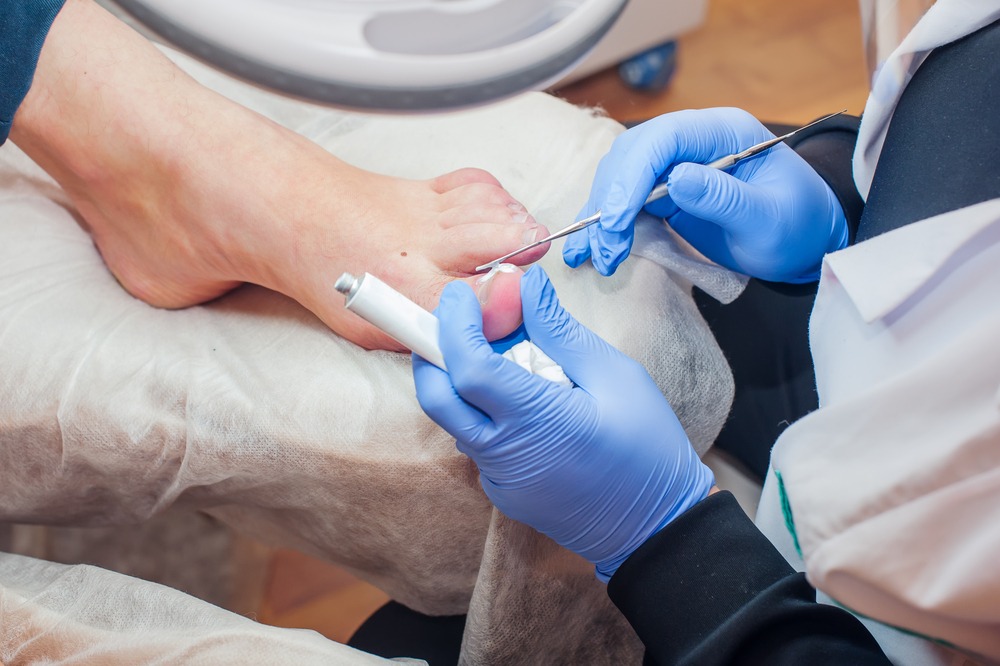
Toenail care, as part of overall foot care, is one of the services offered by chiropodists. Ingrown toenails, which can be very uncomfortable, require professional care to avoid complications. Here are the ingrown toenail treatments offered in a podiatric clinic to fix ingrown toenails permanently.
What is an ingrown toenail?
An ingrown toenail is a nail that grows abnormally into the flesh, creating inflammation. The big toe is most often affected. An ingrown toenail is painful; walking and wearing shoes can worsen if left untreated. Indeed, the pressure and friction created by an ingrown toenail can cause lesions. In an advanced stage, an ingrown toenail can become infected, and the pain can radiate into the foot. This is one of the risks that people with diabetic foot have, as their weakened immunity makes them more vulnerable. If left untreated, an ingrown toenail can develop into an ulcer. For all these reasons, it is recommended to consult a healthcare professional when ingrown toenail symptoms appear.
Causes of ingrown toenails
An improperly cut nail or one that is cut too short is often the cause of an ingrown toenail. But people suffering from nail fungus can also require ingrown toenail treatment as the thickened nail is more prone to ingrown. Finally, people who wear shoes that are too tight can get ingrown toenails because of the pressure on their toes.
Preventing ingrown toenails
To prevent this condition, it is advisable to cut the nail following its shape and file the corners of the nail. Maintaining good foot hygiene can also prevent an ingrown toenail.
When should I see a chiropodist to treat an ingrown toenail?
An ingrown toenail should be treated by a chiropodist if the pain persists or intensifies. An exam is highly recommended if the inflammation is accompanied by an infection (red, warm, swollen skin and pus). In the case of diabetic patients, the infected ingrown toenail can be serious but sometimes difficult to discern from the pain. People with diabetes should therefore check their toes regularly to prevent an ingrown toenail from worsening. In addition, since bacteria thrive in warm, moist environments, such as in shoes, an ingrown toenail can become a prime host for nail fungus.
Ingrown toenail treatment and care
Several ingrown treatments are available to heal an ingrown toenail effectively. Some patients must have the nail cut medically to prevent further bad growth. Ingrown toenail removal should never be done at home; DIY ingrown toenail removal with ingrown toenail tools found at a drugstore can be painful and increase the risk of infection.
In other cases, the affected nail needs pharmacological treatment to eliminate the bacteria and reduce the pain. Since the shape of the nail is affected by this condition, it may be useful to use a splint. The splint is adjusted to the specific size of the nail and guides its regrowth. In addition to these ingrown toenail treatments, a chiropodist may recommend partial or total removal of the ingrown toenail. This involved a surgical procedure under local anesthesia.
Nail care
The most common nail treatment for ingrown toenails is the medical trimming of the nail using specialized and sterilized ingrown toenail tools. If the ingrown toenail is infected, a patient can apply a cream to dislodge the bacteria or soak their foot in an antibiotic solution.
Nail orthotics
Nail orthotics, or orthonyxia or nail splints, are small, rigid devices that fit over the nail and guide its growth. Applying orthonyxia helps to relieve the nail’s weight, reducing pain.
Ingrown toenail surgery
Ingrown toenail surgery is usually the last resort to remove ingrown toenails permanently. A chiropodist ensures that the patient’s quality of life is restored and that the nail is restructured aesthetically. Painkillers can be prescribed to alleviate the postoperative effects. It should be noted that high-impact sports should be avoided during remission.
Foot care in a podiatric clinic
Patients who suffer from nail problems can turn to their chiropodist for all types of conditions. Nail fungus treatment, nail thinning or even nail filing are common foot care treatments offered. Older people and diabetics who may have difficulty with their feet can maintain their quality of life thanks to a chiropodist.

